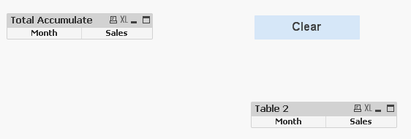Unlock a world of possibilities! Login now and discover the exclusive benefits awaiting you.
- Qlik Community
- :
- All Forums
- :
- QlikView App Dev
- :
- Re: Need Help
- Subscribe to RSS Feed
- Mark Topic as New
- Mark Topic as Read
- Float this Topic for Current User
- Bookmark
- Subscribe
- Mute
- Printer Friendly Page
- Mark as New
- Bookmark
- Subscribe
- Mute
- Subscribe to RSS Feed
- Permalink
- Report Inappropriate Content
Need Help
Hi All.
Please find the attachment of the QVW file in which i have two tables 1. Total Accumulate and Table 2.
as shown in the screenshot below.
My requirement is like.
In Total accumulate if i click on march month which has accumulated 6 sales. as shown in below fig
the it should show me the breakdown of 6 sales in the tables like below screenshot.
I am struggling to get this . help will be really great full.
Please find the attachment of the Qlikview file
Thanks in Advance
Accepted Solutions
- Mark as New
- Bookmark
- Subscribe
- Mute
- Subscribe to RSS Feed
- Permalink
- Report Inappropriate Content
Hey,
Have a look at the attached file. I had to add an extra column to turn the month names into numerical values, otherwise the set analysis in the second table wouldn't work.
Also works for multiple month selections.
Let me know if this works for you and/or if you have any questions.
P.s. credit for the cumulative sum goes to this post.
- Mark as New
- Bookmark
- Subscribe
- Mute
- Subscribe to RSS Feed
- Permalink
- Report Inappropriate Content
For total accumulate count you can try the below expression
sum(aggr(Sum(total {<Month={"<=$(=max(Month))"}>}sales),Month))
and for the detail breakdown you can try
=Sum( {<Month={"<=$(=max(Month))"}>}sales)
- Mark as New
- Bookmark
- Subscribe
- Mute
- Subscribe to RSS Feed
- Permalink
- Report Inappropriate Content
Thanks for the reply Miskinmaz
I tried with your expression but the table are not showing anything , it seems to be wrong .
Below is the screenshot after adding the expressions
Thanks
- Mark as New
- Bookmark
- Subscribe
- Mute
- Subscribe to RSS Feed
- Permalink
- Report Inappropriate Content
I don't have the qlikview to view your application.
You have to check the format of month and what format max(Month) is giving. It is just a format issue I am thinking.
Also I hope that Month is not a string but a date.
- Mark as New
- Bookmark
- Subscribe
- Mute
- Subscribe to RSS Feed
- Permalink
- Report Inappropriate Content
Attaching Excel data ..
and I have converted Month to date in script as well as in excel format.
Thanks
- Mark as New
- Bookmark
- Subscribe
- Mute
- Subscribe to RSS Feed
- Permalink
- Report Inappropriate Content
Sorry I can't help you with the excel file.
Try to add one more expression - max(Month) in a table and see what it is returning. If it is a num then format it .
- Mark as New
- Bookmark
- Subscribe
- Mute
- Subscribe to RSS Feed
- Permalink
- Report Inappropriate Content
This is not working
- Mark as New
- Bookmark
- Subscribe
- Mute
- Subscribe to RSS Feed
- Permalink
- Report Inappropriate Content
Hey,
Have a look at the attached file. I had to add an extra column to turn the month names into numerical values, otherwise the set analysis in the second table wouldn't work.
Also works for multiple month selections.
Let me know if this works for you and/or if you have any questions.
P.s. credit for the cumulative sum goes to this post.
- Mark as New
- Bookmark
- Subscribe
- Mute
- Subscribe to RSS Feed
- Permalink
- Report Inappropriate Content
John, did Jens' last post do the trick for you? If so, please consider giving him credit for the help by using the Accept as Solution button on that post.
Regards,
Brett
I now work a compressed schedule, Tuesday, Wednesday and Thursday, so those will be the days I will reply to any follow-up posts.



